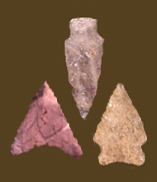
|
CALVERT
The Calvert is typically a short, thick, wide point with rudimentary shoulders, a parallel sided or slightly contracting stem, and a straight or slightly rounded base. The stem often comprises 30 to 50 percent of the total point length. Chronology Description Blade: The blade, thick and irregular in cross section, forms a short and stubby triangle, with convex edges and a sharp tip. Slight but abrupt shoulders separate the blade and the stem. Haft Element: While the base is usually straight, it can be slightly convex. Thinner than the blade, the stem is straight or slightly contracting, and is usually wider than it is long (though in some examples width and length are about equal). Size: Length ranges from 25 to 48 mm, with an average of 36 mm. Width ranges from 18 to 31 mm, with an average of 22 mm. Thickness ranges from 8 to 13 mm, with an average of 10 mm. Technique of manufacture: Moderately well-made using percussion flaking, with limited pressure flaking around the edges. Material: In a sample of 421 Calvert points from the lower Patuxent drainage, Steponaitis (1980) reported that 83% were quartz, followed by rhyolite (9%), quartzite (7%), and chert and argillite (1%). In the area surrounding Zekiah Swamp on the lower Potomac, Wanser (1982) found that 85.5% of 202 Calvert points were quartz, with 7.5% quartzite, 6.5% rhyolite, and 0.5% jasper. At the Accokeek Creek site in Prince Georges County, approximately 90% were quartz and 10% quartzite, with rare examples of shale, chert, and argillite (Stephenson and Ferguson 1963). In the Monocacy River drainage, 65% of 229 Calverts were rhyolite, with 31% quartz and 3% quartzite (Kavanagh 1982). Quartz, quartzite, and rhyolite Calverts are found in the middle Potomac River Valley (Hranicky 2002). Discussion Defined in Literature References Egghart 2014; Hranicky 2002; Kavanagh 1982; Oliver 1981; Reeve 1992; Stephenson and Ferguson 1963; Steponaitis 1980; 1986; Thomas 1981; Wanser 1982; Waselkov 1982 |
![]()
Search by Shape:
(See Projectile Point Typology) |

|
Thank you for visiting our website. If you have any
questions, comments, Copyright © 2002 by |

|

 Defining Attributes
Defining Attributes